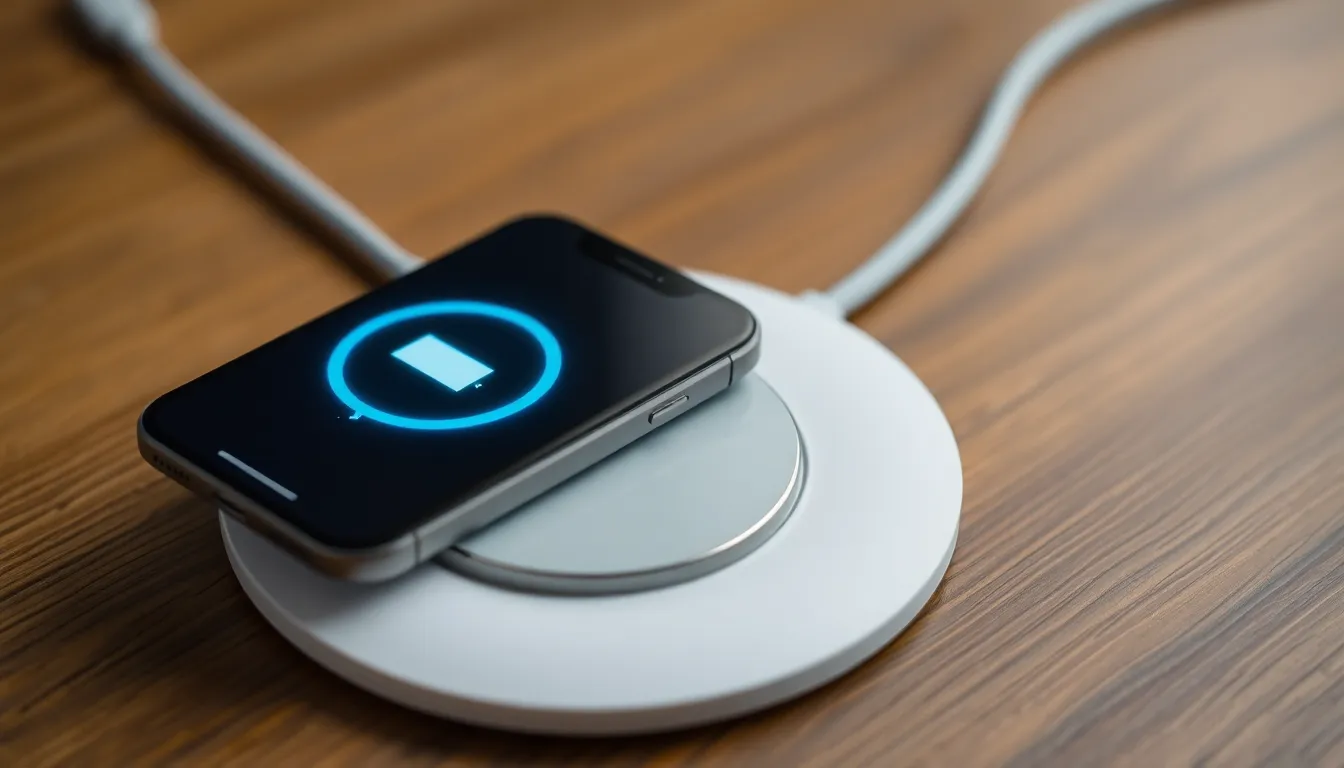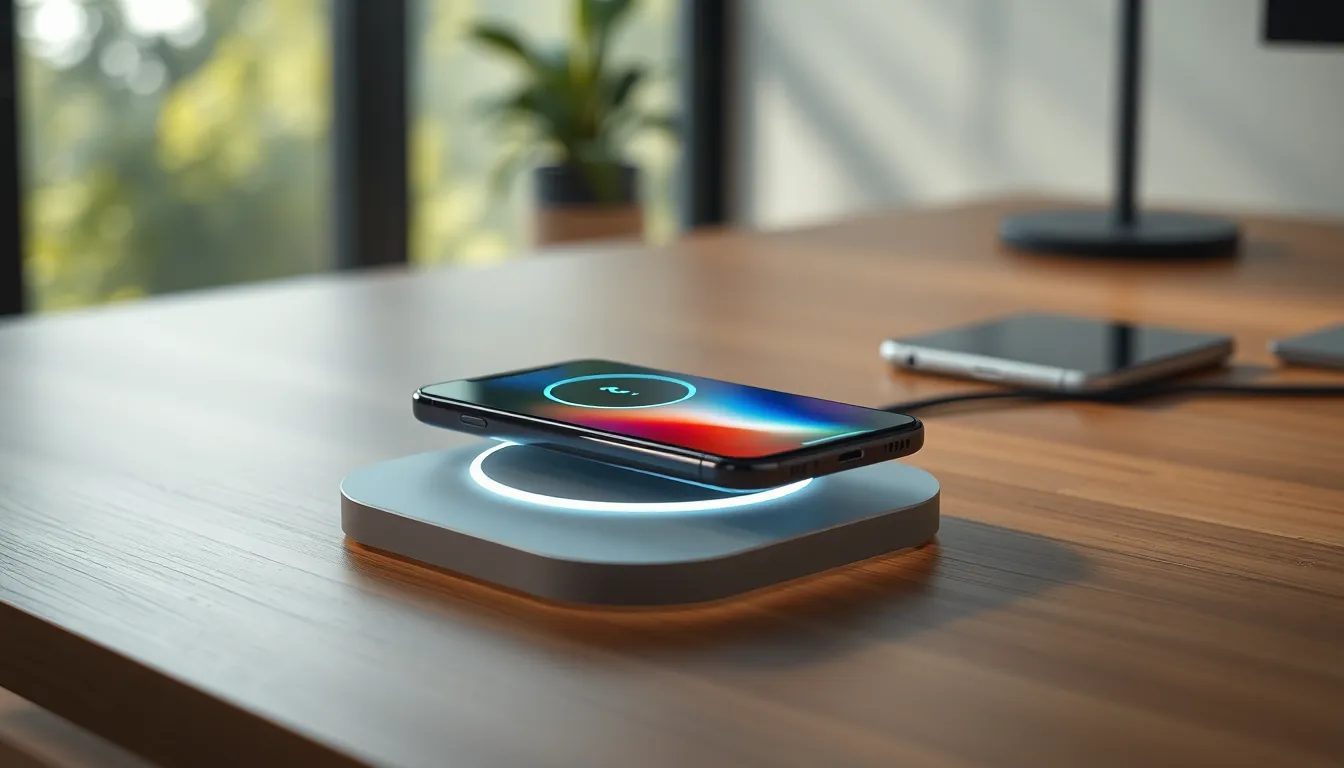Imagine a world where you no longer have to wrestle with tangled cords or play the game of “find the charger.” For many iPhone users, that dream became a reality with the introduction of wireless charging. But when exactly did Apple decide to cut the cord and embrace this futuristic convenience?
The journey began in 2017 with the launch of the iPhone 8 and iPhone X. These devices not only brought a sleek design but also the magic of wireless charging, letting users power up their phones with just a simple placement on a charging pad. It was a game-changer that transformed the way people interacted with their devices. So, let’s dive into the evolution of this technology and explore how it revolutionized the iPhone experience.
Table of Contents
ToggleOverview of Wireless Charging Technology
Wireless charging, often referred to as inductive charging, utilizes electromagnetic fields to transfer energy between two objects. This technology allows devices to charge without the need for physical connection, enhancing convenience for users.
Charging pads or docks serve as the primary components, with coils inside them producing magnetic fields. These fields induce an electric current in the device’s receiving coil, converting it back into stored energy. The Qi standard, developed by the Wireless Power Consortium, has become the prevalent wireless charging protocol, ensuring compatibility across various devices.
Apple incorporated wireless charging into its products starting with the iPhone 8 and iPhone X in 2017, allowing users to enjoy a more streamlined charging experience. Other smartphone manufacturers quickly embraced this technology, offering consumers a wider array of compatible devices.
Efficiency remains a key aspect of wireless charging, with advancements reducing the time required to charge devices. While traditional wired charging often provides faster power delivery, improvements in wireless technology continue to narrow this gap.
Energy losses during the charging process can occur, mainly due to heat generation. Innovations in design and materials help mitigate these losses, improving overall charging efficiency. Many charging pads now include features like alignment tools and foreign object detection, maximizing safety and usability.
Overall, wireless charging represents a significant advancement in mobile technology, greatly enhancing user convenience while reflecting industry trends. As adoption grows, further developments in this space are likely to emerge, promising even better experiences for users.
The Timeline of iPhone Wireless Charging

Wireless charging for iPhones began in 2017, marking a significant shift in user convenience and technology.
The Introduction of Wireless Charging
Apple introduced wireless charging with the iPhone 8 and iPhone X. Both models incorporated Qi technology, allowing users to charge their devices without cables. This innovation greatly improved the overall user experience by reducing the annoyance of tangled cords. The ease of simply placing the device on a charging pad transformed daily charging routines. Enhanced convenience became a central theme as Apple integrated this feature into its product lineup.
Key Milestones in Wireless Charging for iPhone
The launch of the iPhone 8 and X in 2017 set the stage for future models. In 2018, the iPhone XS and XS Max continued this trend by supporting the same Qi wireless charging standard. By 2019, the introduction of the iPhone 11 series added even more advancements in wireless charging efficiency. As models evolved, faster charging capabilities emerged, enabling users to charge their devices more quickly. Adoption of MagSafe in 2020 further enhanced the experience, aligning devices for optimal charging efficiency. These milestones reflect Apple’s commitment to innovation and user-friendly technology.
Comparison with Other Smartphone Brands
Apple’s introduction of wireless charging in 2017 set a new benchmark for the industry. Other brands quickly followed suit, aiming to match the convenience offered by the iPhone. Samsung, for example, launched the Galaxy S6 in 2015, making it one of the first competitors to include wireless charging.
LG also embraced wireless technology with models like the LG G6, which supports Qi wireless charging. Google’s Pixel line introduced compatibility around 2016, incorporating the same Qi standard. These brands illustrate how quickly the market adopted this technology, indicating a shift in consumer preferences.
In terms of charging speeds, Apple’s MagSafe system offers up to 15W, showcasing enhanced efficiency over other systems. Samsung supports similar power levels, particularly with its newer devices. Huawei entered the scene with its SuperCharge technology, providing fast charging capabilities that rival competitors.
Safety features also emerged as crucial in this competitive landscape. Many brands now include foreign object detection and temperature controls, aimed at preventing overheating. The emphasis on user safety shows a collective industry response to potential hazards associated with wireless charging.
Ultimately, Apple’s launching of wireless charging marked a pivotal moment for smartphones. Brands like Samsung, LG, and Google quickly incorporated similar features, creating a diverse ecosystem. This evolution highlights a clear trend: increased adoption and innovation centered around wireless charging technology, responding to consumer needs for convenience and safety in everyday use.
Impact on User Experience
Wireless charging transformed the user experience for iPhone users since its introduction. Convenience became a key benefit, as users no longer faced tangled cords or searched for chargers frequently. Compatibility with the Qi standard made it easy to find charging pads across various brands, enhancing accessibility.
Design innovations played a crucial role in user interaction. Charging pads equipped with alignment tools simplified the process, ensuring devices aligned perfectly every time. Safety features like foreign object detection provided reassurance, further improving usability and trust in the technology.
Efficiency gains also marked the shift in experience. With advancements, energy loss due to heat generation decreased, making wireless charging more reliable. Many users noticed faster charging capabilities with later models, reflecting continuous improvements in technology.
Apple’s MagSafe system, introduced in 2020, elevated the user experience further. This system supports up to 15W charging speeds, offering more power compared to earlier solutions. Enhanced magnetic alignment allowed for quicker and easier connections, reducing the frustration often associated with standard wireless chargers.
Adoption of wireless charging technology by other manufacturers indicated a wider acceptance of the trend. Samsung, LG, and Google quickly followed Apple’s lead, integrating similar features into their devices. This shift showcased evolving consumer preferences, as users increasingly prioritized convenience and efficiency in daily interactions.
Overall, the implementation of wireless charging technology marked a significant improvement in how users engage with their devices. These advancements in user experience continuously influence consumer choices, showcasing a collective shift toward more convenient mobile technology solutions.
Wireless charging has transformed the way users interact with their iPhones since its introduction in 2017. The convenience of charging without cords has quickly become a staple feature for many smartphone users. As Apple continues to innovate with advancements like MagSafe, the user experience only improves, making charging simpler and safer.
The widespread adoption of this technology by various manufacturers highlights its significance in the mobile landscape. As consumers increasingly seek efficiency and ease, wireless charging is poised to remain a key component of future smartphone designs. The ongoing evolution of this technology promises to enhance user experiences even further, solidifying its place in modern mobile interactions.




